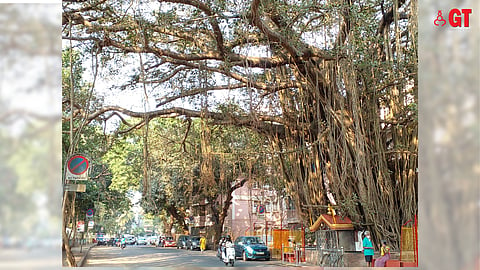

Trees are an integral part of any civilisation. They define not just the ecology of a place, but also the relationship they share with the human community as a whole. No wonder that many trees are considered sacred in various religions all over the globe, and also mainly among tribal communities.
The best example of this is the sacred groves which are also found in Goa. Now, however, they are under tremendous threat due to encroachments, development projects like road-widening, mining, etc.
As we are currently reeling under the impact of climate change, it is pertinent to look at this age-old wisdom of preserving old trees and learning a few lessons about conservation of biodiversity.
TREES IN CULTURE
The recently released book, Sacred Flora of Goa by environmentalist and writer, Rajendra Kerkar, delves deep into this topic. It lists 76 trees, including a mangrove species, which are considered sacred in this part of the world and are worshipped across religions.
The book gives an interesting insight into these trees and helps the reader understand why and how these trees are worshipped, the significance and the medicinal value of these trees.
Most of these trees are native, medicinal and play an important role in ecology as they support a variety of birds, bees, butterflies, etc.
Kerkar, in his note, mentions that the seed of this book was planted during the Covid-19 lockdown. He says, “During Covid-19, when we were living under the scourge of death, the trees always inspired me and helped me to be free of sorrows and suffering.”
The book starts with historic information about how trees are part of our culture – right from the Indus Valley Civilisation to the Mughal Dynasty, who were lovers of gardening. Kerkar has also mentioned tribals – mainly from Madhya Pradesh, Rajasthan – who revere trees.
He has also mentioned Goa’s history related to plant and trees – about Garcia de Orta, who wrote the book Conversations on the simples, drugs and material medica of India in the year 1563. He wrote about the local trees and plants and their medicinal properties.
In 1898, DG Dalgado wrote a catalogue of medicinal plants in Latin that gave information on medicinal uses of plants in Goa and Sawantwadi.
The book also speaks about local vaidya who contributed significantly in furthering the knowledge of ethnobotany.
Kerkar, who is an expert on Goa’s folk and tribal culture and heritage shares information related to tribal communities of Goa like Velip, Dhangar, etc and how the local ecology is a part and parcel of their lifestyle.
He mentions the Velips of Canacona and Sanguem, who observe this tradition of koduva parab during the Hindu month of Bhadrapad.
On this day, the elders of the community collect various leaves, roots, fruits, shoots from the sacred groves, then distribute these to the whole village and make a decoction out of it, which is drunk in the morning before breakfast. It speaks of the ethnobotanical knowledge of the community and also the wisdom of how, when and where to harvest.
He also gives the example of the matoli, a wooden canopy erected during the Ganesh Chaturthi festival, which is a celebration of forests.
RELIGIOUS CONNECTIONS, SPIRITS
The book is peppered with interesting religious folk practices which are connected to trees, such as worshipping certain trees – mango, kadam and umbar – they are considered totem trees in Goa.
He says, “On the occasion of a marriage, a twig of a totem tree is brought and is worshipped with the lamp in front of it. It is believed that the family has evolved from the totem tree. The totem tree is considered a sacred being and believed to possess a spirit.” Totem trees are locally known as Kulvruksha. The book also looks at various festivals like Holi where tall tree trunks or trunk of the arecanut tree is used.
He mentions various trees in different parts of Goa, where these trees are worshipped as they are considered the home of various guardian spirits of Goa. The most common trees are banyan, peepal, mango, devil’s tree, ghoting, etc. These are mostly tall and big trees, which are very old and have been revered for generations.
The book also has interesting images of various trees found in the hinterlands of Goa, especially near a shrine, temple, mosque, church, cross, etc.
The book is an excellent source of documentation of some rare trees like Harkinjal (Sageraea laurifolia), which is not only endemic to the Western Ghats, but in the year 2011, it was in the red list category of the IUCN (International Union for Conservation of Nature) as it has been overused for its timber and medicinal uses.
The book mentions that two of these trees are found near the Sateri-Kelbai Temple in Maulinguem village, in Bicholim. These are protected as they are part of the sacred grove.
The other sacred tree which is not so common is Kosam (Schleichera oleosa) which is known for its bright, red-coloured, new leaves. This tree is also highly medicinal and its wood is used to make various tools. At Muslimwada, in Sanquelim, this tree is considered holy and, thus, protected by local Hindus as well as Muslims.
All such traditions give us hope that in the times to come, if we understand our traditional knowledge of worshipping trees and ecology as a whole, we may be able to deal with the challenges of climate change. Thus, it is necessary to speak and write about such trees, plants, shrubs, etc, which are in many ways, the reason for our survival.
The book, ‘Sacred Flora of Goa’ by Rajendra Kerkar, published by Vivekananda Environment Awareness Brigade (VEAB), Keri, Sattari has been sponsored by NABARD, Panjim, and is available at Broadway Book Centre, Panjim.